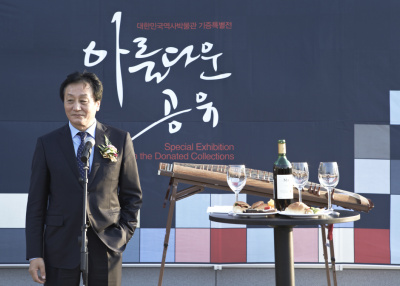
Professor Kim Wang-sik, at the moment, the director of the National Museum of Korean Contemporary History (MUCH), overlooks the Gwanghwamun Square from his office located on the 7th floor of the museum. Professor Kim was inaugurated as the very first director of MUCH in 2012.
Upon graduating from Yonsei University in Korea and majoring in Political Diplomacy, Professor Kim went to the United States and received a master’s degree in the same major at the University of Missouri-Columbia. Since September 1991 until 2012, professor Kim taught Ewha students politic courses in the department of Social Studies Education. Professor Kim believes that a student who learns political science has the responsibility to dedicate his or her knowledge to the Korean society.
“Coming back to Korea after studying in the United States was reasonable because as a professor of political science, I always wanted to use my knowledge to make Korean society a better place to live in,” professor Kim said. “Just when I came back to Korea in 1991, I started to give lectures at Ewha and continued doing so until 2012.”
The National Museum of Korean Contemporary History (MUCH) was established to organize and introduce Korea’s accomplishments in contemporary history to the public. Korea is the one and only country that has made both economic development and democratization after the World War II in 1945.
In December 2012, professor Kim was designated as the first director of MUCH. Even though he was not a specialist in the field of exhibition, he was considered a qualified candidate for his knowledge and dedication to Korean contemporary history.
“Contemporary history is a research field for both history and social science scholars,” professor Kim said. “That may be the reason why I was chosen as the director of MUCH.”
The 17th government put together a committee in April 2009 in succession to President Lee’s proclamation of constructing a contemporary history museum in Korea.
While professor Kim received unprecedented support from the government in organizing the museum, there were hardships he had to overcome until the opening of the museum.
“During the four years in which the MUCH committee laid its foundation, some people criticized that the museum was built only to emphasize economic development and denigrate democratic achievements of Korea,” professor Kim said. “The museum, however, proved that it was absolutely objective in exhibiting Korea’s contemporary history so the concerns diminished after its opening.”
Ever since professor Kim took office in MUCH, the museum has been putting great efforts in order to carry out the roles of a contemporary history museum which are-collecting objects, research, exhibition, and education.
The museum collects data related to Korean contemporary history and digitizes them for the public or other researchers to see. With the collected historical objects, the researchers conduct research with balanced perspective.
“Contemporary history in Korea is in the middle of controversy most of the time so researchers try to find a compromising point,” professor Kim said. “MUCH arranges a place where open discussions on contemporary history are encouraged through its compilation of academic journals.”
Professor Kim believes that education is as important as the other three functions of a museum.
Adding to the already existing education programs, the museum is further planning to develop more in-depth and interesting education programs for the public.
Such efforts found rich fulfillment. Since its opening in December 2012, over a million people have visited MUCH. The museum is planning to develop both the quality of contents and public relations.
“We aim to have more visitors this year through various advertisements and more interesting programs,” professor Kim said. “We still need more museum storage space and rooms for special exhibitions, but I am sure that these problems will be solved as time goes.”
Emphasizing the importance of having a broad perspectives when looking at both history and the world as a whole, professor Kim advises Ewha students to have a broader point of view in life.
“Ewha students are the most hard-working students I have seen, but they seem to be weak in extending the scope of their personal relations,” professor Kim said. “In order to look at history in a balanced perspective, Ewha students should have the courage to learn about many people of different situations.”
Lee Ha-kyung
voteforkate@ewhain.net

